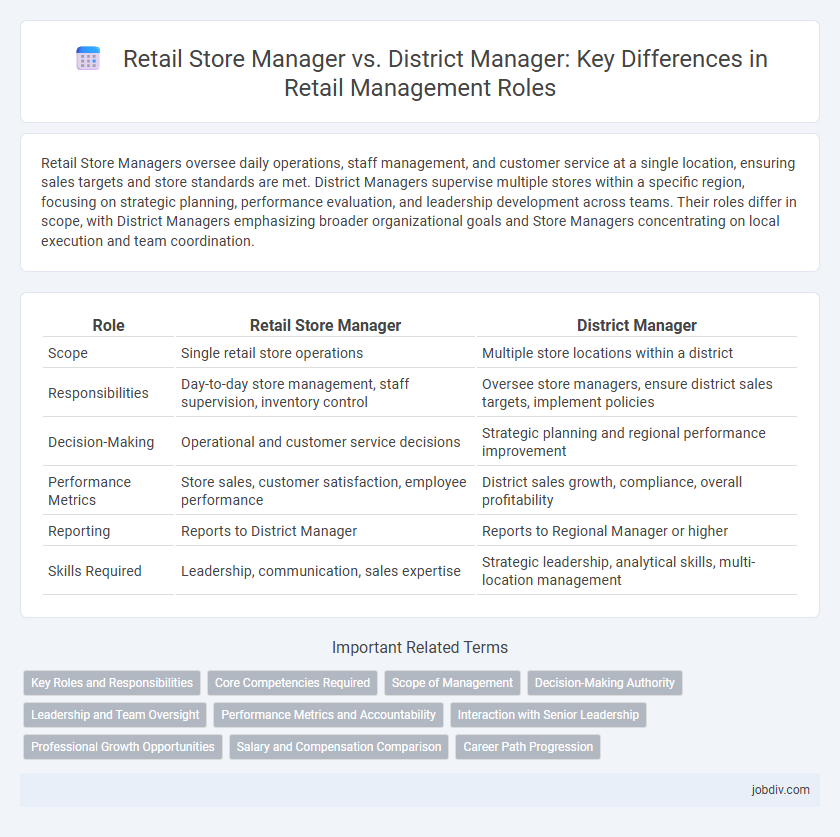Retail Store Managers oversee daily operations, staff management, and customer service at a single location, ensuring sales targets and store standards are met. District Managers supervise multiple stores within a specific region, focusing on strategic planning, performance evaluation, and leadership development across teams. Their roles differ in scope, with District Managers emphasizing broader organizational goals and Store Managers concentrating on local execution and team coordination.
Table of Comparison
| Role | Retail Store Manager | District Manager |
|---|---|---|
| Scope | Single retail store operations | Multiple store locations within a district |
| Responsibilities | Day-to-day store management, staff supervision, inventory control | Oversee store managers, ensure district sales targets, implement policies |
| Decision-Making | Operational and customer service decisions | Strategic planning and regional performance improvement |
| Performance Metrics | Store sales, customer satisfaction, employee performance | District sales growth, compliance, overall profitability |
| Reporting | Reports to District Manager | Reports to Regional Manager or higher |
| Skills Required | Leadership, communication, sales expertise | Strategic leadership, analytical skills, multi-location management |
Key Roles and Responsibilities
A Retail Store Manager oversees daily store operations, including staff management, inventory control, and customer service to ensure smooth functioning and sales targets are met. In contrast, a District Manager supervises multiple stores within a specific region, focusing on performance metrics, strategic planning, and implementing corporate policies across all locations. Both roles require leadership and operational expertise, but the District Manager has a broader scope involving cross-store coordination and higher-level management responsibilities.
Core Competencies Required
A Retail Store Manager excels in customer service expertise, inventory control, and team leadership within a single store environment. In contrast, a District Manager requires advanced strategic planning skills, multi-store operational oversight, and strong financial acumen to drive performance across multiple locations. Both roles demand excellent communication, problem-solving abilities, and a focus on achieving sales targets, but the scale and scope of responsibility significantly differentiate their core competencies.
Scope of Management
A Retail Store Manager oversees the daily operations, staff, inventory, and customer service within a single store, ensuring efficient and effective store-level management. In contrast, a District Manager governs multiple retail locations across a geographic region, focusing on broader strategic initiatives, performance metrics, and consistency across stores. The scope of management for a District Manager spans operational oversight, employee development, and profitability across several stores, whereas the Retail Store Manager concentrates on executing these objectives at the individual store level.
Decision-Making Authority
Retail Store Managers exercise decision-making authority primarily over daily store operations, including staffing, inventory control, and customer service strategies within a single location. District Managers hold broader decision-making power, overseeing multiple stores across a region, implementing company policies, and driving regional sales targets by coordinating store managers. The scope of decision-making authority for District Managers is strategic and multi-site, while Retail Store Managers focus on tactical, single-store execution.
Leadership and Team Oversight
Retail Store Managers lead daily store operations, directly supervising staff and ensuring customer satisfaction through hands-on team management and motivation. District Managers oversee multiple store locations, providing strategic leadership, performance evaluation, and operational consistency across the district. Effective leadership at both levels requires strong communication, problem-solving skills, and the ability to inspire teams while aligning with broader company objectives.
Performance Metrics and Accountability
Retail Store Managers are directly accountable for individual store performance metrics such as sales targets, customer satisfaction scores, and inventory management, ensuring daily operations align with company standards. District Managers oversee multiple stores, analyzing aggregated performance data to drive strategic improvements, streamline processes, and ensure consistency across their region. Their accountability extends to broader targets including overall district revenue, employee productivity, and compliance with corporate policies.
Interaction with Senior Leadership
A Retail Store Manager typically interacts with senior leadership through regular performance reports, operational updates, and implementing corporate strategies at the store level. In contrast, a District Manager maintains more frequent and strategic communication with senior leadership, providing insights across multiple stores, aligning district objectives with company goals, and influencing regional decision-making. This hierarchical interaction allows District Managers to act as a critical link between frontline retail operations and executive management.
Professional Growth Opportunities
Retail Store Managers gain hands-on leadership experience by overseeing daily operations, team management, and customer engagement, which sharpens skills essential for career advancement. District Managers oversee multiple store locations, developing strategic planning, multi-site team leadership, and operational efficiency expertise that positions them for higher executive roles. Progressing from Retail Store Manager to District Manager expands management scope, enhances decision-making capabilities, and increases responsibilities critical for senior leadership development in the retail industry.
Salary and Compensation Comparison
Retail Store Managers typically earn an average annual salary ranging from $45,000 to $65,000, with compensation often including bonuses, profit-sharing, and commission based on store performance. District Managers receive significantly higher pay, with salaries commonly between $75,000 and $120,000 per year, reflecting their broader responsibilities overseeing multiple store locations, plus additional incentives like performance bonuses and stock options. Both roles may offer benefits such as health insurance and retirement plans, but overall compensation for District Managers is more lucrative due to expanded management scope and strategic duties.
Career Path Progression
Retail Store Managers develop direct leadership skills by overseeing daily store operations, managing staff, and driving sales performance, which builds a strong foundation for higher management roles. District Managers expand their responsibilities by supervising multiple store locations, focusing on strategic planning, regional sales targets, and cross-store team leadership. Progression from Retail Store Manager to District Manager typically involves mastering operational excellence, scalable team management, and advanced business analytics.
Retail Store Manager vs District Manager Infographic

 jobdiv.com
jobdiv.com